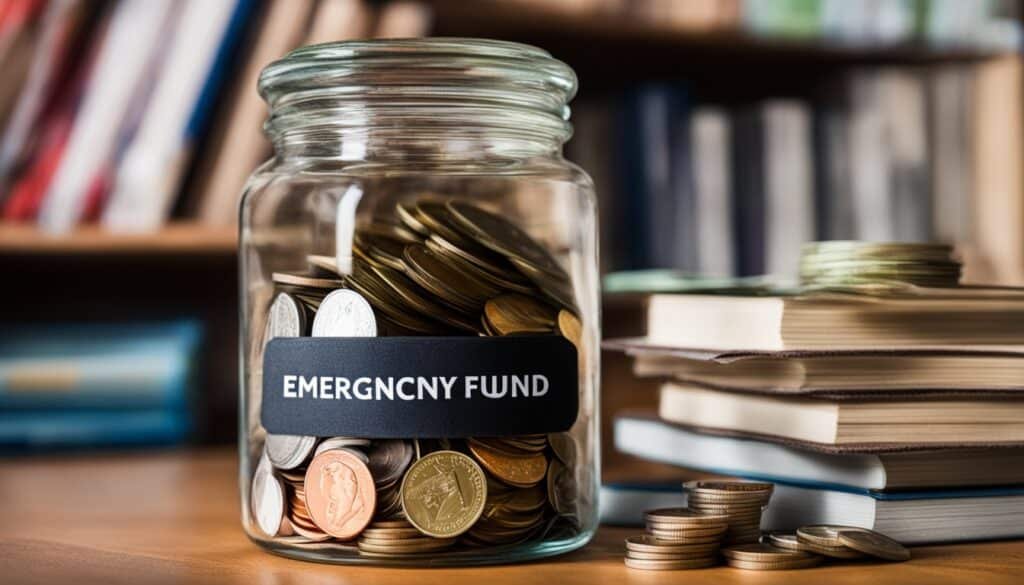Financial Planning: Saving for unplanned costs is crucial. An emergency fund can keep you safe from tough times. It’s important to have extra cash set aside to avoid sudden financial problems. A 2022 Bankrate survey found that just 44% of Americans could deal with a $1,000 emergency from their savings. And with inflation getting worse, saving for unexpected expenses is becoming harder for many.
Key Takeaways
- An emergency fund is crucial for protecting against unexpected financial challenges and avoiding debt or credit card dependency.
- Determining the appropriate size for your emergency fund involves evaluating your expenses, income, dependents, and job security.
- Building your emergency fund can be achieved through setting smaller, achievable goals and automating regular contributions.
- It’s important to avoid overspending and taking on new debt while saving for emergencies to ensure the fund remains available when needed.
- Once your emergency fund target is reached, any additional savings should be directed towards other financial priorities, such as retirement planning.
The Importance of an Emergency Fund
An emergency fund is essential in any smart money plan. It acts as a safety net, saving you from financial surprises. Instead of using credit or going into debt, it lets you pull money from savings for sudden costs. This keeps your finances on track and stops you from owing more money.
Protecting Against Financial Shocks
Life throws unexpected things our way, and not all are good. It could be a medical emergency, losing your job, or needing a big home fix. These surprises can ruin your budget. But, with an emergency fund, you have a cushion. You won’t have to touch your retirement or sell your investments. You also won’t need to get loans with high interest. This way, your financial health stays strong.
Also Read: What Are The Financial Instruments Available For Wealth Growth?
Avoiding Debt and Credit Card Reliance
If a surprise expense hits, using credit might seem like the easy way out. But, this can start a bad cycle of debt and high interest. A good emergency fund means you won’t need to rely on credit cards. It won’t force you to take out loans. So, you can get past financial hurdles without damaging your credit or budget in the long run.
Determining Your Emergency Fund Goal

Evaluating Your Expenses and Income
First, look at your financial situation. Check your monthly cash flow, credit card debt, and other bills. This shows the least amount you need to keep your life going.
Also, think about your income and how secure your job is. It gives an idea of what to save for emergencies.
Also Read: How Do I Evaluate A Stocks Before Investing?
Considering Dependents and Job Security
If you have people depending on you, like a family, saving more is wise. This ensures they are okay if an emergency hits. For those relying on one income or who work for themselves, saving up to eight months of expenses is smart. It helps if there’s a job loss or your income changes abruptly.
On average, saving three to six months of expenses is suggested for your emergency fund. Yet, how much you need really depends on your personal financial situation. Also, your comfort with risk plays a role. Look at your expenses, income, dependents, and job stability closely. This will guide you to the right emergency fund goal. It supports your financial goals and gives peace of mind against sudden twists.
Also Read: How Can I Calculate Capital Gains On Real Estate Investments?
Strategies for Building Your Emergency Fund

Creating an emergency fund isn’t as hard as it might seem. A good tactic is to start small and gradually increase your saving aim. This way, you keep your spirits up and the habit alive.
Setting Smaller, Achievable Goals
Begin by trying to save at least one month’s expenses, then move up from there. By stepping your targets up slowly, you make the whole saving operation feel more doable and less scary.
Starting with Small, Regular Contributions
Don’t underestimate the power of little, regular savings. By setting a certain sum aside each month, following your financial plan, you’ll inch closer to your target. Little by little, it will all add up.
Also Read: Top 9 Technology Trend You Must Keep An Eye On
Automating Your Savings
Setting up automatic saving transfers can revolutionize your emergency fund collection. This helps keep your financial planning in shape with minimal effort on your part. Just put some away regularly and stay the course.
Avoiding Overspending and New Debt
When you’re building your emergency fund, it’s a must to dodge overspending and steering clear of fresh debt. Touching your emergency savings often or relying on credit cards is a warning sign. It means your spending habits could use a serious check. Keep your eyes on the prize and ensure your emergency fund remains a safety net.
Sticking to your financial plan and saying no to new debt is key to mastering your money. It also helps in reaching your long-term financial goals. Prioritizing emergency savings means you can face any financial shocks that come your way. Your financial situation won’t take a big hit.
Always remember, a firm financial plan with a good emergency fund gives peace of mind. It means you can face the unknown with boldness. Making wise financial decisions and staying disciplined in your savings and spending is crucial. This way, you’re step closer to reaching your financial goals. Plus, you’re working towards a prosperous financial future.
Also Read: How Secure Is Domain Hosting?
Don’t Over-Save in Your Emergency Fund

It’s key to build an emergency fund for financial planning. But, don’t save too much in it. After hitting your goal, usually three to six months’ expenses, focus on other financial priorities.
Too much in an emergency account won’t grow well. This can hurt your long-term financial goals.
Prioritizing Retirement Savings
Focus on a strong retirement plan for a secure financial future. After setting up your emergency fund, put more into retirement accounts. Think about options like 401(k)s or individual retirement accounts (IRAs).
These choices offer tax benefits. They can help you reach your money goals over time.
Earning Higher Returns
Usually, emergency funds sit in safe, low-earning accounts. This ensures quick access when you need it. But, after hitting your goal, look at investment options for better returns.
Consider things like mutual funds, exchange-traded funds (ETFs), or individual stocks. Mixing your investment portfolio can bring better gains. Yet, you’ll still have some money in your easy-to-reach emergency fund.
Also Read: Explore New Possibilities With A Degree In Finance
Financial Planning
Creating a strong financial plan is vital for reaching your money goals over time. It’s good to include emergency savings in your plan. It helps cover short-term needs while still saving for the future.
Incorporating Emergency Savings into Your Plan
Discuss with a financial expert the importance of saving for emergencies. They can help you find the right amount suited to your finances. This step is key for a complete financial plan that looks at both the present and the future.
Reviewing and Adjusting Your Plan Regularly
Regular check-ins on your financial plan are a must. This includes your emergency savings. As your life changes, you might need to update how much you’re saving for emergencies. Keeping in touch with your advisor and being open to change is essential for meeting your financial aims.
FAQs
Q: How can I start saving for emergencies in my financial planning?
A: One way to start saving for emergencies is by setting up an emergency fund. This fund should cover 3-6 months’ worth of living expenses in case of unexpected events like job loss or medical emergencies.
Q: What is the role of a financial planner in helping me save for emergencies?
A: A financial planner can help you assess your current financial situation, set financial goals, and create a plan to save for emergencies. They can provide guidance on building an emergency fund that fits your needs.
Q: How can a certified financial planner assist me in my financial planning?
A: A certified financial planner (CFP) has the expertise and knowledge to guide you through various aspects of financial planning, including saving for emergencies. They can create a comprehensive financial plan tailored to your specific goals.
Q: What are some common investment options to consider for emergency savings?
A: Some common investment options for emergency savings include high-interest savings accounts, money market accounts, or short-term bonds. These options provide liquidity while also earning some interest.
Q: How does financial planning for retirement tie into saving for emergencies?
A: Financial planning for retirement often includes building an emergency fund as part of a comprehensive plan. This ensures you are prepared for unexpected expenses both before and during retirement.
Q: What steps can I take to ensure my emergency savings are secure?
A: To secure your emergency savings, consider keeping the funds in a separate account, regularly reviewing and replenishing the fund, and avoiding unnecessary withdrawals for non-emergencies.
Q: Why is it important to consult a financial advisor for emergency savings?
A: A financial advisor can provide personalized advice based on your financial goals and risk tolerance. They can help you establish an emergency fund that aligns with your overall financial plan.
Source Links
- https://www.morganstanley.com/articles/how-to-build-an-emergency-fund
- https://www.consumerfinance.gov/an-essential-guide-to-building-an-emergency-fund/
- https://www.securian.com/insights-tools/articles/5-steps-to-building-an-emergency-fund.html




